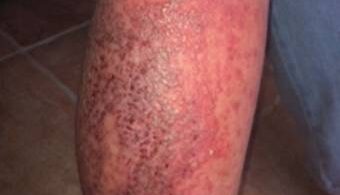The patient is an 85-year-old man. One evening, he starts complaining of a pressing pain on his bladder and of having to go the bathroom with increasing frequency all night. He is accustomed to frequent urination for many years, but has put it down to age, and an enlarged prostate (BPH). His PSA is normal (2.4). He takes no medication for the prostate, because he is allergic to many medications.
After the frequency and pressing pain get worse through the night, in the early morning, he goes to the ER, and they determine that he is retaining a large amount of urine (over 500 ml) in his bladder which is causing the pain. They insert a Foley catheter and ask him to see his primary care physician.
The Foley catheter is an indwelling catheter, which means it is going to stay in place until removed. It involves living with a plastic bag tied to the thigh which collects the urine, and the bag needs to be changed every night to a different bag for sleeping. The longer it stays in, the higher the risk of infection.
The primary care physician starts him on Tamsulosin which is an alpha-blocker that relaxes the muscles in the prostate and bladder neck, making it easier to urinate. She refers him to a urologist, and he gets an appointment for a month away.
The urologist asks him to get a urodynamic study done, which involves assessing how the bladder and urethra are performing their job of storing and releasing urine. The patient has however been feeling dizzy and nauseous while taking Tamsulosin, so that is discontinued.
The urologist starts him on Proscar (Finasteride) which is another drug used to treat BPH. By the time of the urodynamic study, it has been two months since the catheter was inserted. The patient is also suffering rare side-effects of Finasteride such as swelling of the feet and dizziness, so that drug is also discontinued.
During this time, I prescribed Sabal Serrulata mother tincture (10 drops twice a day) for his BPH. Boericke says, “Sabal is homeopathic to irritability of the genito-urinary organs… Of unquestioned value in prostatic enlargement…and urinary difficulties. Acts on membrano-prostatic portion of urethra”.
I also asked him to take D-Mannose, to prevent UTIs due to the catheter. He has the catheter inserted, so there is no way to tell if a homeopathic remedy will work, since there is no way to measure its efficacy.
The urodynamic study reveals that he is still retaining urine (650 ml), and the Foley catheter which was removed for the study is reinserted. At the next appointment with the urologist to review the results of the study, the patient is told that his bladder is too weak to empty on its own (atony), and this is leading to urinary retention. The Foley catheter erodes the urethral meatus if it’s kept in for too long, so he has three difficult options to choose from:
1) Suprapubic catheter: A suprapubic catheter is a urinary catheter that empties the bladder through an incision in the belly instead of a tube in the urethra. This would be permanent, and hence prone to infections.
2) Clean intermittent catheterization: Self-catheterization every 4 to 6 hours. The patient has to learn to self-catheterize but there is a lower risk of infection.
3) TURP: surgery used to treat urinary problems due to an enlarged prostate
These are all unpleasant options. Given the patient’s age, he prefers to avoid surgery and opts for self-catheterization, which turns out to be a very difficult and painful process for him. At this point, I treat him with a homeopathic remedy.
I treat this as an acute rather than a constitutional case, since the priority is to get him off the need for catheters as soon as possible and avoid ending up in the ER again. The repertorization is below:
I decide to give him three doses of Cantharis 30C. The response was remarkable. By the next morning, he was able to urinate on his own, just as he was before the first catheter was inserted four months ago, but with no pain or pressure. There is no need for the catheters at all.
He does not mind the frequency, because being able to urinate normally is such a relief after the intrusive and painful experiences he has had over the last four months with the catheters. A month later, he says he has some mucus and sediment in the urine. I repeat Cantharis 30c, and the mucus goes away.
He then has an appointment with the urologist who is incredulous to hear that he has not been using catheters. The urologist says he has never seen a case like this where there is a recovery of bladder function, given that the patient is not taking any medications, given the prolonged use of the Foley catheter, and given results of the urodynamic study which showed the patient’s bladder retaining huge quantities of urine.
He was skeptical, and said, ‘Maybe you think you are okay but you are probably retaining urine, and that can be harmful for your kidneys eventually’. He asked the patient to void his bladder and performed a bladder ultrasound to check, and sees that the bladder had indeed emptied properly, and there was no retention. He chalked it up to a medical mystery I suppose, but the patient was grateful for the power of homeopathy.






Very good madam congrats for nice effort.
I am also not a Dr.but doing for homeopathy since last 25 years with our ngo getting very good result in our rural areas with qualified homeopathy Dr.
Keep sharing regularly.
Excellent.
I am a Type2 Diabetic.
Since last 1 year I have frequent urination.
Do you suggest any homeopathic medicine
excellent Dr..really very helpfull.. I am not a doctor but very mch follw homeopathy…. proved ince again homeo will be certailny remembered in SOS situations
Cantharis 30 is best choice. Excellent. It is better for patient if he is advised to take Sabal serulata as his suffering is due to prostate, to avoid occurence of such problem.
Good Morning Swapna Honavar our Homeopapathic Expert!
I have calcification in both breasts , I believe it is caused from over indulgence of calcium. I had it in 2004 in my right breast only & I was given surgery to remove it.. I have been using Vitamin C with calcium ascorbate in it. I now again have calcification in both breasts. I do not want surgery again I have read that the homeopath remedy SEPIA will remove the calcification. Do you know if the remedy SEPIA is effective for removing the calcification? I can’t find where I read that sepia is good for this problem & I don’t want breasts cancer. I am scared.
Very good use of Cantharis for bladder issues.
Do you reckon using cell salts to support him, long term?
any Idea anybody which program has been used for repertorization
Bravo!